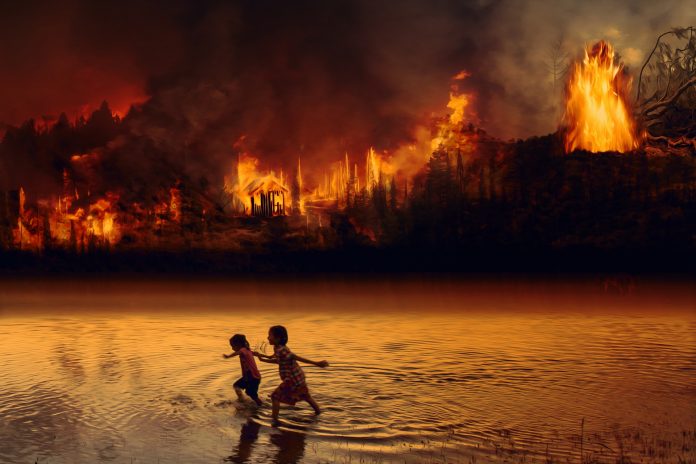The turn of the last millennium has witnessed a horde of monumental events. Among these, the spirals of overpopulation have made their exploits duly felt as well. Starting from the advent of the industrial revolution to the modern-day peril of overpopulation, mankind’s harshness never seems to cease. The fact that we happen to be the root of all our problems seems to be perpetually lost on us. In all of the collective afflictions that we impose, a quotient of collateral damage always seems to hold itself constant. This constant is what we refer to in a most beloved manner as Mother Nature. The 2019 Amazon Rainforest fire is searing testimony to this particular statement.
Table of Contents
Man-made disasters
The annals of history are well ripe with mentions of disfigurement that mankind has left in its selfish wake. From multiple newspaper headlines to endless news hour marquees, these ravages find documentation in all walks of life. At this point it’s fair to adjudge that we’ve taken more than we can possibly ever give. But the history of civilization has long been shaped by askew narratives. And hence, much to our chagrin, this particular plot shall take the same path as well. Ranging from gas leaks to oil spills to nuclear meltdowns, the list is painstakingly long and endless.
The sensationalism that arises from these occurrences is arrestingly trifling. And at the heart of all of these events, lies a lesson that never seems to find its needful vocation. To err is human, and indeed that is what we relentlessly do. Despite the catastrophic consequences our empathy confines itself to the tethered cameras and microphones of the next door journalist. To add to that, the sordid heads of political figures never seem shy of planting their seeds of propaganda. The 2019 Amazon Rainforest fire is vehement proof of our offhandedness and callousness to our surroundings.
Relative Incidents
While we were seemingly drowned in the Amazon Rainforest fire facts, we could never foster active steps. Agreed, the tumultuous dimensions of the mishap would have overwhelmed any human intervention and interference. However, we made no remote attempt to decipher the underlying causative agent in the first place. It is this very apathy that cripples our inherent sense of civic responsibility in the first place. And that is exactly what makes the narrative of manmade disasters a reiterating one. Collectively, we don’t dwell enough upon the consequences to shiver at the possibilities of incepting another such event.
The Bhopal Gas Tragedy of 1984 and the Chernobyl Meltdown of 1986 are the most recognized nadirs of humanity. Both of these cataclysmic events have found abundant documentation and sensationalism in the annals of pop culture as well. However, despite significant campaigns, the brevity of tragedy never seems to desert us. In this particular scenario, a poignant question demands reckoning. Do we attribute this brevity to our apathy or to the unrivaled optimism of the human race? Whatever the answer might be, its vitality already seems to be extremely inconsequential at the outset.
What are Wildfires?
Before we attempt to decipher the Amazon Rainforest fire cause, it’s important to grasp the core concept behind it. Knowing what a wildfire is in the first place will help us better comprehend the significance of event at hand. The subsequent global response that this event triggered was a momentous turn in mankind. The reader stands to better perceive this significance only when they have knowledge of the fundamental nature of this disaster. Broadly put, a wildfire is an untethered flame in a wide area of vegetation that is generally considered combustible. Also referred to as wildland fire or rural fire these types of occurrences are more frequent in rural areas.
A wildfire in general is an umbrella term that plays host to a diverse range of classifications. Usually these classifications divide themselves on the different kinds of vegetation that are visible around us. Subsequently these classifications are known as brush fire, hill fire, peat fire, forest fire and veld fire among others. In essence wildfires owe their provenance to a bevy of causative agents. Notable among them are our carbon-rich vegetation, seasonally dry climates, atmospheric oxygen and natural lightning.
How forest fires spread
Volcanic ignitions are among the most widespread reasons for triggering wildfires as well. Owing to all of these attributes planet earth is considered to be an intrinsically flammable planet by large. In this light the effect of fire as a physical element has had pronounced evolutionary impacts. These consequences reflect directly on the ecosystem through the scope of earth’s flora and fauna. Though it is a devastating phenomenon, occasional naturally occurring wildfires renders positive impact as well. These beneficial consequences manifest themselves in the evolution of native vegetation, animals and subsequently the ecosystem. Goes without saying, the damaging nature of wildfires has seen with it the advent of effective countermeasures also.
One such popular measure used to curb wildfires is referred to as controlled burning. This method involves igniting a small fire on purpose to directly limit the spread of the existent wildfire. As the manufactured small fire starts forcefully consuming the available combustible resources, the prevalent widespread wildfire starts diminishing as well. Among the horde of other wildfire prevention techniques, a major chunk of them fall under the banner of preemptive measures.
Amazon Rainforest fire 2019
The 2019 occurrences of the Amazon Rainforest fire took the entire world by storm. The fires phased themselves out as an entire season that witnessed a year to year increase in the fires. This spread encompassed the Amazon rainforest and the Amazon biome and held itself relevantly during the Amazonian tropical dry season. The increasing rate of slash and burn methods of deforestation in that region is among the primary reasons for fires. Farming in the jungle proved to be among the most relevant reasons behind the 2019 Amazon Rainforest fire. Land clearing for agricultural purposes and cattle ranching led to large scale depletion in the Amazonian rainforest vegetation.
An astounding statistic exists to drive this point home and to elaborate on the significance of it. About 93 million acres of the Amazonian rainforest now dons the official identification tag of that of farmland. This lofty figure accounts for about twelve percent of the entire Amazonian expanse. As a result food production in Amazon has taken a substantial hit since the year of 2004. Even though stringent federal policies are being set up to discourage such activity, their implementation is rather lax. Ambitious infrastructure development plans in the Amazonian waterways is among other contributing factors to this conundrum.
What led the mishap
Elaborate plans were in place to set up a series of hydroelectric dams atop Amazon’s untapped rivers. Road choked streams that punctuate the wide expanse of forest cover is also responsible for this mishap. Perched culverts that double up as informal bridges are the primary factors for blocking water flow in these streams. A growing number of these obstacles have inevitably affected the broader expanse of Amazonian waterways. The makeshift road crossings bring about damage in a twofold manner. At the outset, they cause vicious shore erosion thus attracting a sea of vulnerability.
Additionally, they are also responsible for building up silt in the streams. This causes the quality of the resident water to deteriorate dramatically which subsequently affects the health of its inhabitants. In a habitat that is as intertwined as the Amazonian rainforest, even a minor development can lead to widespread consequences. All of these factors culminated in the eventual occurrence of the 2019 Amazon Rainforest fire. Pictures taken of the forest fires from space gained instant prominence within minutes of their publication. Searing lines of orange set against the dull black background etched an indelible mark in the minds of their audience.
Environmental Impact of the Amazon Rainforest fire
A mishap of this magnitude and dimension seldom leaves without any collateral damage. This philosophy certainly held itself to be true at the time of the 2019 Amazon Rainforest fire. The environmental impact of this tragedy was primarily felt in two particular domains. The manifestations of this damage were in the form of emissions and harm to biodiversity. Carbon dioxide and carbon monoxide emissions underwent tangible spikes owing to the prolonged fires.
Smoke engulfed those areas that were located downwind to the fire. This brought about a horde of health-related issues for the residents of those regions. Hospitals started reporting a surge in the influx of their cases. This figure held itself at thrice the average cases pertinent to smoke-related health hazards. The billowing smoke also put the populace at risk of other seriously fatal other conditions. Cases of asthma and bronchitis saw a rise in this particular phase of smoke encapsulation. Additionally, both the youngsters and the elderly stood at substantial risk of contracting cancer because of the toxic environment.
How biodiversity is at risk
In addition to emissions the smoke put the delicate construct of biodiversity at great risk as well. Already adjudged as near threatened by the World Wildlife Fund, the jaguar was pushed to a further critical situation. The Amazon rainforest is not fire-adapted courtesy of its ecosystem and has suffered heavy losses at the wildfire’s hands. Subsequently this demanding toll was exacted on the wildlife that harbors themselves within the forest’s wide expanse. An event as unprecedented as this one caught them absolutely unawares and inflicted irrecoverable damage. Species such as lizards, sloths, frogs and anteaters ran the risk of getting perished in exorbitant numbers.
Owing to the delicate ecosystem, the resulting fauna of the Amazon rainforest is increasingly vulnerable to large fires as well. Moreover, the energy flow of the food web also stood critically disturbed by this phenomenon. The pervading fires obliterated the dense canopy out of existence in its wake. Subsequently, the subordinate tiers of the ecosystem were subject to widespread exposure. This disrupted the consequent energy of the food web by discernible margins. Alterations with the chemistry of the water resulted in widespread loss of aquatic life as well.
The Global Response
The unprecedented fires evoked massive reactions and responses from people of all quarters of life. People ranging from celebrities to commoners all got together to spread awareness and raise help towards this cause. The dimensionality of this occurrence caused the Bishops Conference of Latin America to give this event identification of tragedy. Subsequently, it urged the United Nations and the International community at large to brainstorm active damage control measures. The governments of the Amazonian countries were made active delegates in this crucial decision-making process. The weeks before the G7 talks held between August 24 to 26 led conversations in this particular regard. The degree of fire and the subsequent damage that they caused received much deliberation in this period.
The fires that received massive media coverage held the diplomatic fraternity in their grip as well. The possibility of setting up an international statute aimed at preserving the rainforest was pitched during these discussions too. Consequently an emergency aid worth $22 million was all set to be issued to the concerned Amazonian countries. However, owing to multiple political conflicts of interest the funding never saw the light of the day.
Brazilian President Jair Bolsonaro ended outright denying the G7 emergency fund to begin with. Days later he convened a summit for the Amazonian countries that was held at Colombia on September 6. Delegates from 7 countries were in attendance for this particular meet. They included Colombia, Brazil Peru, Ecuador, Guyana, Suriname and Bolivia. The summit concluded in the participating countries signing a pact in order to systemize monitoring of forest and optimize disaster response.
Concluding Remarks
The Amazon Rainforest fire of 2019 undoubtedly registered itself among the most significant events of the present decade. In the widespread devastation that it resulted in, it certainly brought about a wave of self-realization. Incidents such as these ones are highly avoidable only if we choose to a little more considerate about our surroundings. Harnessing a sense of civic responsibility is the need of the hour. For at the end of the day we need to realize that this is the only planet we call home.








